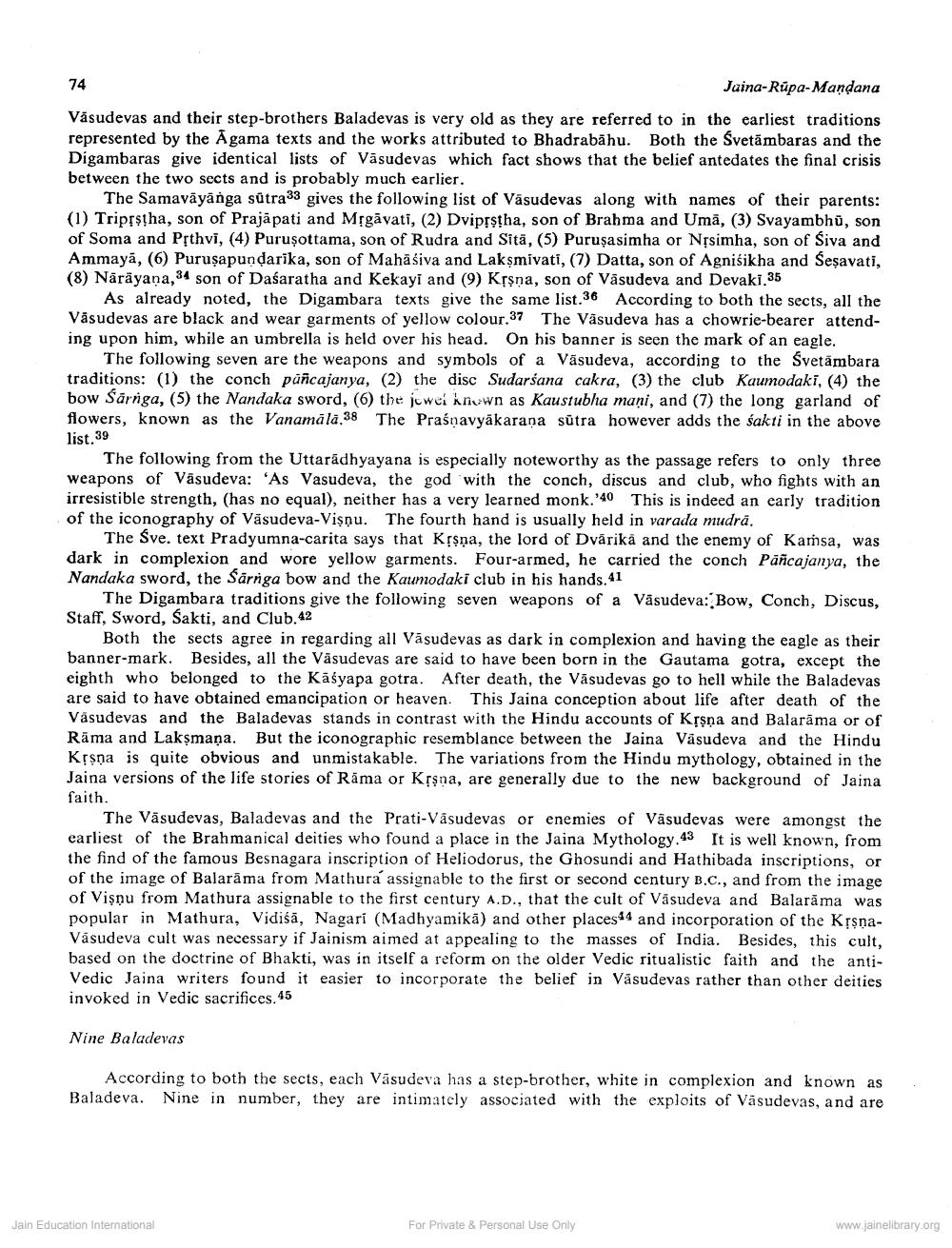________________
Jaina-Rupa-Mandana
Väsudevas and their step-brothers Baladevas is very old as they are referred to in the earliest traditions represented by the Agama texts and the works attributed to Bhadrabāhu. Both the Svetāmbaras and the Digambaras give identical lists of Vasudevas which fact shows that the belief antedates the final crisis between the two sects and is probably much earlier.
The Samavāyānga sütra33 gives the following list of Vasudevas along with names of their parents: (1) Triprstha, son of Prajapati and Mrgāvati, (2) Dviprstha, son of Brahma and Umā, (3) Svayambhu, son of Soma and Prthvi, (4) Purusottama, son of Rudra and Sitā, (5) Purusasimha or NȚsimha, son of Siva and Ammaya, (6) Purusapundarika, son of Mahāśiva and Lakşmivati, (7) Datta, son of Agniśikha and Sesavati, (8) Nārāyana, 34 son of Dasaratha and Kekayi and (9) Kșsna, son of Vasudeva and Devaki.35
As already noted, the Digambara texts give the same list.36 According to both the sects, all the Vasudevas are black and wear garments of yellow colour.37 The Väsudeva has a chowrie-bearer attending upon him, while an umbrella is held over his head. On his banner is seen the mark of an eagle.
The following seven are the weapons and symbols of a Vasudeva, according to the Svetambara traditions: (1) the conch pañcajanya, (2) the disc Sudarśana cakra, (3) the club Kaumodaki, (4) the bow Sarriga, (5) the Nandaka sword, (6) the jwei kriuwn as Kaustubha mani, and (7) the long garland of flowers, known as the Vanamala,38 The Praśnavyäkarana sútra however adds the sakti in the above list. 39
The following from the Uttarādhyayana is especially noteworthy as the passage refers to only three weapons of Väsudeva: "As Vasudeva, the god with the conch, discus and club, who fights with an irresistible strength, (has no equal), neither has a very learned monk.'40 This is indeed an early tradition of the iconography of Väsudeva-Vişnu. The fourth hand is usually held in varada mudra.
The Sve. text Pradyumna-carita says that Krsna, the lord of Dvārika and the enemy of Kansa, was dark in complexion and wore yellow garments. Four-armed, he carried the conch Pancajanya, the Nandaka sword, the Sārniga bow and the Kaumodaki club in his hands.41
The Digambara traditions give the following seven weapons of a Vasudeva: Bow, Conch, Discus, Staff, Sword, Sakti, and Club.42
Both the sects agree in regarding all Vasudevas as dark in complexion and having the eagle as their banner-mark. Besides, all the Väsudevas are said to have been born in the Gautama gotra, except the eighth who belonged to the Kāśyapa gotra. After death, the Vasudevas go to hell while the Baladevas are said to have obtained emancipation or heaven. This Jaina conception about life after death of the Väsudevas and the Baladevas stands in contrast with the Hindu accounts of Krsna and Balarāma or of Rāma and Lakşmaņa. But the iconographic resemblance between the Jaina Vasudeva and the Hindu Krsna is quite obvious and unmistakable. The variations from the Hindu mythology, obtained in the Jaina versions of the life stories of Rāma or Krsna, are generally due to the new background of Jaina faith.
The Vasudevas, Baladevas and the Prati-Vasudevas or enemies of Väsudevas were amongst the earliest of the Brahmanical deities who found a place in the Jaina Mythology.43 It is well known, from the find of the famous Besnagara inscription of Heliodorus, the Ghosundi and Hathibada inscriptions, or of the image of Balarāma from Mathura assignable to the first or second century B.C., and from the image of Visnu from Mathura assignable to the first century A.D., that the cult of Vasudeva and Balarama was popular in Mathura, Vidiśä, Nagari (Madhyamikā) and other places 44 and incorporation of the KrsnaVasudeva cult was necessary if Jainism aimed at appealing to the masses of India. Besides, this cult, based on the doctrine of Bhakti, was in itself a reform on the older Vedic ritualistic faith and the antiVedic Jaina writers found it easier to incorporate the belief in Vasudevas rather than other deities invoked in Vedic sacrifices. 45
Nine Baladevas
According to both the sects, each Vasudeva has a step-brother, white in complexion and known as Baladeva. Nine in number, they are intimately associated with the exploits of Väsudevas, and are
Jain Education International
For Private & Personal Use Only
www.jainelibrary.org




